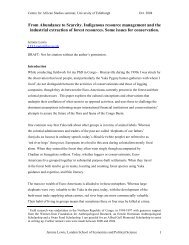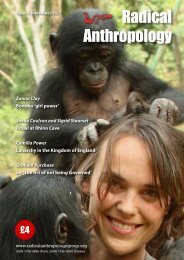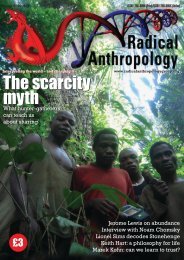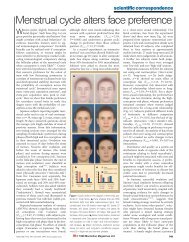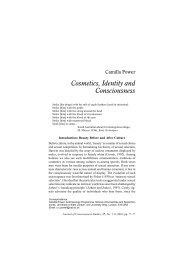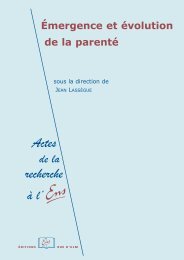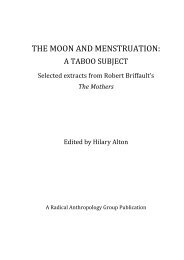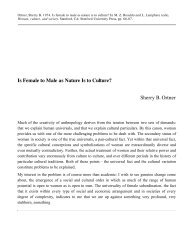Language and life history: A new perspective on the development ...
Language and life history: A new perspective on the development ...
Language and life history: A new perspective on the development ...
- No tags were found...
You also want an ePaper? Increase the reach of your titles
YUMPU automatically turns print PDFs into web optimized ePapers that Google loves.
References/Locke & Bogin: <str<strong>on</strong>g>Language</str<strong>on</strong>g> <str<strong>on</strong>g>and</str<strong>on</strong>g> <str<strong>on</strong>g>life</str<strong>on</strong>g> <str<strong>on</strong>g>history</str<strong>on</strong>g>Nazzi, T., Bert<strong>on</strong>cini, J. & Mehler, J. (1998) <str<strong>on</strong>g>Language</str<strong>on</strong>g> discriminati<strong>on</strong> by <str<strong>on</strong>g>new</str<strong>on</strong>g>borns:Toward an underst<str<strong>on</strong>g>and</str<strong>on</strong>g>ing of <strong>the</strong> role of rhythm. Journal of ExperimentalPsychology: Human Percepti<strong>on</strong> <str<strong>on</strong>g>and</str<strong>on</strong>g> Performance 24:756–66. [KW]Neisser, U., ed. (1998) The rising curve: L<strong>on</strong>g-term gains in IQ <str<strong>on</strong>g>and</str<strong>on</strong>g> relatedmeasures. American Psychological Associati<strong>on</strong>. [DFB]Nels<strong>on</strong>, K. (1996) <str<strong>on</strong>g>Language</str<strong>on</strong>g> in cogniti<strong>on</strong>: The emergence of <strong>the</strong> mediated mind.Cambridge University Press. [SJC](1973) Structure <str<strong>on</strong>g>and</str<strong>on</strong>g> strategy in learning to talk. M<strong>on</strong>ographs of <strong>the</strong> Society forResearch in Child Development 38, 1–2 (Serial no. 149). [rJLL](1981) Individual differences in language <strong>development</strong>: Implicati<strong>on</strong>s for<strong>development</strong> <str<strong>on</strong>g>and</str<strong>on</strong>g> language. Developmental Psychology 17:170–87. [rJLL](1996) Memory <strong>development</strong> from 4 to 7 years. In: The five to seven year shift:The age of reas<strong>on</strong> <str<strong>on</strong>g>and</str<strong>on</strong>g> resp<strong>on</strong>sibility, ed. A. J. Sameroff & M. M. Haith.University of Chicago Press. [aJLL]Nels<strong>on</strong>, K. & Fivush, R. (2004) The emergence of autobiographical memory: Asocial cultural <strong>development</strong>al <strong>the</strong>ory. Psychological Review111(2):486–511. [SR]Nels<strong>on</strong>, K. & L. K. Shaw (2002). Developing a socially shared symbolic system. In:<str<strong>on</strong>g>Language</str<strong>on</strong>g>, literacy <str<strong>on</strong>g>and</str<strong>on</strong>g> cognitive <strong>development</strong>, ed.J. Byrnes & E. Amseli, pp.27–57. Erlbaum. [SJ]Newbury, D. F., B<strong>on</strong>ora, E., Lamb, J. A., Fisher, S. E., Lai, C. S. L., Baird, G.,Jannoun, L., Sl<strong>on</strong>ims, V., Stott, C. M., Merricks, M. J., Bolt<strong>on</strong>, P. F., Bailey,A. J., M<strong>on</strong>aco, A. P. & <strong>the</strong> Internati<strong>on</strong>al Molecular Genetic Study of AutismC<strong>on</strong>sortium. (2002) FOXP2 is not a major susceptibility gene for autism orspecific language impairment. American Journal of Human Genetics70:1318–27. [LW]Newmeyer, F. J. (2004) Grammar is grammar <str<strong>on</strong>g>and</str<strong>on</strong>g> usage is usage. <str<strong>on</strong>g>Language</str<strong>on</strong>g>80:682–707. [aJLL]Newport, E. (1981) C<strong>on</strong>straints <strong>on</strong> structure: evidence from American Sign<str<strong>on</strong>g>Language</str<strong>on</strong>g> <str<strong>on</strong>g>and</str<strong>on</strong>g> language learning. In: Minnesota Symposium <strong>on</strong> Child Psychology,vol. 14: Aspects of <strong>the</strong> <strong>development</strong> of competence, ed. W. A. Collins,pp. 93–124. Erlbaum. [aJLL]Ninio, A. & Snow, C. (1996) Pragmatic <strong>development</strong>. Westview Press. [SR]Ninio, A., Snow, C., Pan, B. A. & Rollins, P. R. (1994) Classifying communicativeacts in children’s interacti<strong>on</strong>s. Journal of Communicati<strong>on</strong> Disorders 27:158–87. [aJLL]Nippold, M. (1998) Later language <strong>development</strong>: The school-age <str<strong>on</strong>g>and</str<strong>on</strong>g> adolescentyears, 2nd editi<strong>on</strong>. Pro-ed. [aJLL]Nippold, M. A. & Taylor, C. L. (2002) Judgments of idiom familiarity <str<strong>on</strong>g>and</str<strong>on</strong>g> transparency:A comparis<strong>on</strong> of children <str<strong>on</strong>g>and</str<strong>on</strong>g> adolescents. Journal of Speech,<str<strong>on</strong>g>Language</str<strong>on</strong>g>, <str<strong>on</strong>g>and</str<strong>on</strong>g> Hearing Research 45:384–91. [aJLL]Nishida, T., Takasaki, H. & Takahata, Y. (1990) Demography <str<strong>on</strong>g>and</str<strong>on</strong>g> reproductiveprofiles. In: The chimpanzees of <strong>the</strong> Mahale Mountains: Sexual <str<strong>on</strong>g>and</str<strong>on</strong>g> <str<strong>on</strong>g>life</str<strong>on</strong>g><str<strong>on</strong>g>history</str<strong>on</strong>g> strategies, ed. T. Nishida, pp. 63–97. University of TokyoPress. [aJLL]Northcutt, R. G. (1990) Ontogeny <str<strong>on</strong>g>and</str<strong>on</strong>g> phylogeny: A re-evaluati<strong>on</strong> of c<strong>on</strong>ceptualrelati<strong>on</strong>ships <str<strong>on</strong>g>and</str<strong>on</strong>g> some applicati<strong>on</strong>s. Brain, Behavior <str<strong>on</strong>g>and</str<strong>on</strong>g> Evoluti<strong>on</strong> 36(2-3):116–40. [aJLL]Nowak, M. A. & Komarova, N. L. (2001) Towards an evoluti<strong>on</strong>ary <strong>the</strong>ory oflanguage. Trends in Cognitive Sciences 5:288–95. [HB]Odling-Smee, F. J., Lal<str<strong>on</strong>g>and</str<strong>on</strong>g>, K. N. & Feldman, M. W. (2003) Nichec<strong>on</strong>structi<strong>on</strong>: The neglected process in evoluti<strong>on</strong>. Princet<strong>on</strong> UniversityPress. [aJLL]Ohala, J. J. (2005) Ph<strong>on</strong>etic explanati<strong>on</strong>s for sound patterns. Implicati<strong>on</strong>s forgrammars of competence. In: A figure of speech: A festschrift for John Laver,ed. W. J. Hardcastle & J. M. Beck, pp. 23–38. Erlbaum. [rJLL]Oller, D. K. (2000) The emergence of <strong>the</strong> capacity for speech. Erlbaum. [aJLL, DKO](2004) Underpinnings for a <strong>the</strong>ory of communicative evoluti<strong>on</strong>. In: The evoluti<strong>on</strong>of communicati<strong>on</strong> systems: A comparative approach, ed. D. K. Oller &U. Griebel, pp. 49–65. MIT Press. [aJLL, DKO]Oller, D. K., Eilers, R. E., Neal, A. R. & Schwartz, H. K. (1999) Precursors tospeech in infancy: The predicti<strong>on</strong> of speech <str<strong>on</strong>g>and</str<strong>on</strong>g> language disorders. Journal ofCommunicati<strong>on</strong> Disorders 32:223–45. [aJLL]Oller, D. K. & Griebel, U. (2005) C<strong>on</strong>textual freedom in human infant vocalizati<strong>on</strong><str<strong>on</strong>g>and</str<strong>on</strong>g> <strong>the</strong> evoluti<strong>on</strong> of language. In: Evoluti<strong>on</strong>ary <str<strong>on</strong>g>perspective</str<strong>on</strong>g>s <strong>on</strong> hum<str<strong>on</strong>g>and</str<strong>on</strong>g>evelopment, ed. R. Burgess & K. MacD<strong>on</strong>ald, pp. 135–66. SagePublicati<strong>on</strong>s. [DKO]Oller, D. K. & Griebel, U., eds. (2004) The evoluti<strong>on</strong> of communicati<strong>on</strong> systems: Acomparative approach. MIT Press. [aJLL]Olss<strong>on</strong>, R. & Powers, D. (2003) Machine learning of human language throughautomatic programming In: Proceedings of <strong>the</strong> 4th Internati<strong>on</strong>al C<strong>on</strong>ference <strong>on</strong>Cognitive Science, University of New South Wales, July 2003, ed. P. Slezak,pp. 507–12. University of New South Wales Press. [DMWP]Ong, W. J. (1982) Orality <str<strong>on</strong>g>and</str<strong>on</strong>g> literacy: The technologizing of <strong>the</strong> word.Methuen. [arJLL]Oyama, S. (2001) What is <strong>development</strong>al systems <strong>the</strong>ory? In: Cycles of c<strong>on</strong>tingency:Developmental systems <str<strong>on</strong>g>and</str<strong>on</strong>g> evoluti<strong>on</strong>, ed. S. Oyama, P. E. Griffiths & R. D.Gray, pp. 1–12. MIT Press. [LJG]Oyama, S., Griffiths, P. E. & Gray, R. D. (2001) Cycles of c<strong>on</strong>tingency: Developmentalsystems <str<strong>on</strong>g>and</str<strong>on</strong>g> evoluti<strong>on</strong>. MIT Press. [LJG]Paine, R. L. & Hawkes, K., eds. (2006) The evoluti<strong>on</strong> of human <str<strong>on</strong>g>life</str<strong>on</strong>g> <str<strong>on</strong>g>history</str<strong>on</strong>g>. Schoolof American Research. [rJLL]Palombit, R. A., Cheney, D. L. & Seyfarth, R. M. (1999) Male grunts as mediators ofsocial interacti<strong>on</strong> with females in wild chacma babo<strong>on</strong>s (Papio cynocephalusursinus). Behaviour 136:221–42. [aJLL]Papoušek, M. & Papoušek, H. (1981) Musical elements in <strong>the</strong> infant’s vocalizati<strong>on</strong>:Their significance for communicati<strong>on</strong>, cogniti<strong>on</strong>, <str<strong>on</strong>g>and</str<strong>on</strong>g> creativity. In: Advancesin infancy research, vol. 1, ed. L. P. Lipsitt. Ablex. [DLB]Paradis, M., ed. (1998) Pragmatics in neurogenic communicati<strong>on</strong> disorders.Pergam<strong>on</strong>. [aJLL]Parker, S. T. (2000) Homo erectus infancy <str<strong>on</strong>g>and</str<strong>on</strong>g> childhood: The turning point in <strong>the</strong>evoluti<strong>on</strong> of behavioral <strong>development</strong> in hominids. In Biology, brains, <str<strong>on</strong>g>and</str<strong>on</strong>g>behavior: The evoluti<strong>on</strong> of human <strong>development</strong>, ed. S. T. Parker, J. Langer &M. L. McKinney, pp. 279–318. School of American Research Press. [BJK]Passes, A. (2004) The place of politics: Powerful speech <str<strong>on</strong>g>and</str<strong>on</strong>g> women speakers ineveryday Pa’ikwené (Palikur) <str<strong>on</strong>g>life</str<strong>on</strong>g>. Journal of <strong>the</strong> Royal AnthropologicalInstitute 10:1–18. [aJLL]Paul, R. (1995) <str<strong>on</strong>g>Language</str<strong>on</strong>g> disorders from infancy through adolescence:Assessment<str<strong>on</strong>g>and</str<strong>on</strong>g> interventi<strong>on</strong>. Mosby. [aJLL]Pavelka, M. S. & Fedigan, L. M. (1991) Menopause: A comparative <str<strong>on</strong>g>life</str<strong>on</strong>g> <str<strong>on</strong>g>history</str<strong>on</strong>g><str<strong>on</strong>g>perspective</str<strong>on</strong>g>. Yearbook in Physical Anthropology 34:13–38. [aJLL]Pawlby, S. J. (1977) Imitative interacti<strong>on</strong>. In: Studies in mo<strong>the</strong>r-infant interacti<strong>on</strong>,ed. H. R. Schaffer. Academic Press. [aJLL]Pawley, A. (1991) How to talk cricket: On linguistic competence in a subject matter.In: Currents in Pacific linguistics: Papers <strong>on</strong> Austr<strong>on</strong>esian languages <str<strong>on</strong>g>and</str<strong>on</strong>g> ethnolinguisticsin h<strong>on</strong>our of George W. Grace, ed. R. Blust, pp. 339–68. PacificLinguistics, Series C-117. [aJLL]Pedersen, M. F., Møller, S., Krabbe, S. & Bennett, P. (1986) Fundamental voicefrequency measured by electroglottography during c<strong>on</strong>tinuous speech: A <str<strong>on</strong>g>new</str<strong>on</strong>g>exact sec<strong>on</strong>dary sex characteristic in boys in puberty. Internati<strong>on</strong>al Journal ofPediatric Otorhinolaryngology 11:21–27. [aJLL]Pedersen, M. F., Møller, S., Krabbe, S., Bennett, P. & Svenstrup, B. (1990) Fundamentalvoice frequency in female puberty measured with electroglottographyduring c<strong>on</strong>tinuous speech as a sec<strong>on</strong>dary sex characteristic: A comparis<strong>on</strong>between voice, pubertal stages, oestrogens <str<strong>on</strong>g>and</str<strong>on</strong>g> <str<strong>on</strong>g>and</str<strong>on</strong>g>rogens. Internati<strong>on</strong>alJournal of Pediatric Otorhinolaryngology 20:17–24. [aJLL]Peek, P. (1981) The power of words in African verbal arts. The Journal of AmericanFolklore 94:19–43. [rJLL]Pepperberg, I. M. (1981) Functi<strong>on</strong>al vocalizati<strong>on</strong>s by an African Grey Parrot(Psittacus erithacus). Zeitschrift für Tierpsychologie 55:139–60. [DLB](1983) Cogniti<strong>on</strong> in <strong>the</strong> African Grey parrot: Preliminary evidence for auditory/vocal comprehensi<strong>on</strong> of <strong>the</strong> class c<strong>on</strong>cept. Animal Learning <str<strong>on</strong>g>and</str<strong>on</strong>g> Behavior11:179–85. [DLB]Pereira, M. E. (1993) Evoluti<strong>on</strong> of <strong>the</strong> juvenile period in mammals. In: Juvenileprimates: Life <str<strong>on</strong>g>history</str<strong>on</strong>g>, <strong>development</strong>, <str<strong>on</strong>g>and</str<strong>on</strong>g> behavior, ed. M. E. Pereira & L. A.Fairbanks, pp. 17–27. Oxford University Press. [aJLL]Pereira, M. E. & Altmann, J. (1985) Development of social behavior in free-livingn<strong>on</strong>human primates. In: N<strong>on</strong>human primate models for human growth <str<strong>on</strong>g>and</str<strong>on</strong>g><strong>development</strong>, ed. E. S. Watts, pp. 217–309. Alan R. Liss. [aJLL, GEW]Pereira, M. E. & Fairbanks, L. A., eds. (1993) Juvenile primates: Life <str<strong>on</strong>g>history</str<strong>on</strong>g>,<strong>development</strong>, <str<strong>on</strong>g>and</str<strong>on</strong>g> behavior. Oxford University Press. [aJLL]Peters, A. M. (1983) The units of language acquisiti<strong>on</strong>. Cambridge UniversityPress. [KK]Philbrick, F. A. (1949) <str<strong>on</strong>g>Language</str<strong>on</strong>g> <str<strong>on</strong>g>and</str<strong>on</strong>g> <strong>the</strong> law: The semantics of forensic English.Macmillan. [aJLL]Pinker, S. (1999) Words <str<strong>on</strong>g>and</str<strong>on</strong>g> rules. Basic Books. [LW]Pinker, S. & Bloom, P. (1990) Natural language <str<strong>on</strong>g>and</str<strong>on</strong>g> natural selecti<strong>on</strong>. Behavioral<str<strong>on</strong>g>and</str<strong>on</strong>g> Brain Sciences 13:707–84. [aJLL, DKO]Pinker, S. & Jackendoff, R. (2005). The faculty of language: What’s special about it?Cogniti<strong>on</strong> 95:201–236. [LW]Place, K. S. & Becker, J. A. (1991) The influence of pragmatic competence <strong>on</strong> <strong>the</strong>likeability of grade-school children. Discourse Processes 14:227–41. [aJLL]Plant, G. (1984) The effects of an acquired profound hearing loss <strong>on</strong> speech producti<strong>on</strong>.British Journal of Audiology 18:39–48. [aJLL]Plant, T. M. & Barker-Gibb, M. L. (2004) Neurobiological mechanisms of pubertyin higher primates. Human Reproducti<strong>on</strong> Update 10:67–77. [rJLL]Plavcan, J. & van Schaik, C. (1997) Interpreting hominid behavior <strong>on</strong> <strong>the</strong> basis ofsexual dimorphism. Journal of Human Evoluti<strong>on</strong> 32:345–74. [PK]Ploog, D. W. (1992) The evoluti<strong>on</strong> of vocal communicati<strong>on</strong>. In: N<strong>on</strong>verbal vocalcommunicati<strong>on</strong>, ed. H. Papoušek, U. Jurgens & M. Papoušek, pp. 6–30.Cambridge University Press. [DLB]Plummer, T. (2004) Flaked st<strong>on</strong>es <str<strong>on</strong>g>and</str<strong>on</strong>g> old b<strong>on</strong>es: Biological <str<strong>on</strong>g>and</str<strong>on</strong>g> cultural evoluti<strong>on</strong>at <strong>the</strong> dawn of technology. American Journal of Physical Anthropology, Suppl.39:118–64. [aJLL]Popper, K. (1963) C<strong>on</strong>jectures <str<strong>on</strong>g>and</str<strong>on</strong>g> refutati<strong>on</strong>s, Routledge <str<strong>on</strong>g>and</str<strong>on</strong>g> KeganPaul. [DMWP]BEHAVIORAL AND BRAIN SCIENCES (2006) 29:3 321



